A limited selection of posts on Social Media that reflect, report on public discussion of current, forest- and forestry-related issues in Nova Scotia by ‘both sides of the aisle’. Not attempting to be comprehensive. “Big Forestry” is given a sep. page.
Subpages:
– Big Forestry
– Natural History Articles
Page initiated Sep 22, 2024.
“ReWild: The Art & Science” Nov1-22, 2025 in Annapolis Royal (Anouncement)
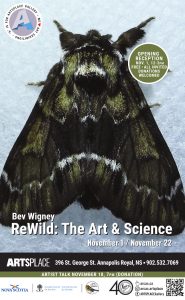
ReWild: The Art & Science
ANNAPOLIS ROYAL, Nova Scotia (October 14, 2025) – ARTSPLACE Gallery presents “ReWild: The Art & Science” , a multidisciplinary exhibition by naturalist and artist Bev Wigney. This project chronicles a fifteen-year journey of ecological restoration and creative observation on a two-acre property beside the Round Hill River. …
Bev Wigney’s “ReWild: The Art & Science” opening reception Sat. November 1, 2025, 12-2 p.m. Light refreshments served, all welcome. Artist talk November 18, 7p.m. (donation). Exhibition continues through November 22.
ARTSPLACE is a public Art Gallery that is operated by the Annapolis Region Community Arts Council, a registered charitable, community organization dedicated to encouraging and promoting the arts… ARTSPLACE Gallery is located at 396 St. George Street in Annapolis Royal, Nova Scotia. Read More
Oct 5, 2025:
David Wimberley
“Lost in awe at the beauty around me, I must have slipped into a state of heightened awareness. It is hard – impossible really – to put into words the moment of truth that suddenly came upon me then. Even the mystics are unable to describe their brief flashes of spiritual ecstasy. It seemed to me, as I struggled afterward to recall the experience, the self was utterly absent: I and the chimpanzees, the earth and trees and air, seemed to merge, to become one with the spirit power of life itself. The air was filled with a feathered symphony, the evensong of birds. I heard new frequencies in their music and also in singing insects’ voices – notes so high and sweet, I was amazed. Never had I been so intensely aware of the shape, the color of the individual leaves, the varied patterns of the veins that made each one unique. Scents were clear as well, easily identifiable: fermenting, overripe fruit; waterlogged earth; cold, wet bark; the damp odor of chimpanzee hair, and yes, my own too. And the aromatic scent of young, crushed leaves was almost overpowering.
That afternoon, it had been as though an unseen hand had drawn back a curtain and, for the briefest moment, I had seen through such a window. In a flash of “outsight” I had known timelessness and quiet ecstasy, sensed a truth of which mainstream science is merely a small fraction. And I knew that the revelation would be with me for the rest of my life, imperfectly remembered yet always within. A source of strength on which I could draw when life seemed harsh or cruel or desperate.”
~ Jane Goodall
Sep 16, 2024:
Tim Houston interview on the Todd Veinotte show from Sept. 16
Interview with Premier Houston just after the 45 minute mark
Among the comments by the Premier:
– “The forest is a garden, and it has to be managed and gardened….”
– “One of the things that I think surprises a lot of people is that in NS, over the last few years, more trees have died than have been harvested.”
Tip of the Hat to ML for forwarding this one
COMMENT from NSFM: The Premier could benefit from Forest Ecology 101…
– Our forests serve commercial functions and natural functions or “Ecosystem Services”. By and large, the latter are best served by un-managed forests, hence the whole rationale and science around Protected Areas etc., and the sometimes practice of leaving un-managed patches within managed forests (although larger or more deliberately designed patches may be required to be effective)
– Trees that grow old and die naturally in forests are of immense benefit to wildlife, e.g., “snags” (standing dead trees) provide nests for a wide range of cavity dwellers, and for many forms of wildlife that feed off of organisms growing on decaying wood.
Sep 14, 2024
I had the privilege this weekend to visit the Mi’Kmaw Land Defenders on Hunters Mountain in Unama’ki.
Rene Doucet Cottreau on Friends of Goldsmith Lake FB page; cc’d on NSFM
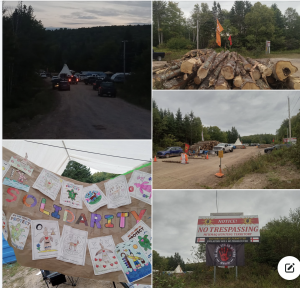 The experience was quite incredible and unlike anything I’ve had in protest camps before.
The experience was quite incredible and unlike anything I’ve had in protest camps before.
The scale of their movement is striking. There couldn’t have been less than 40 of us in attendance last night. Elders sat around the stoves chatting in Miꞌkmawiꞌsimk while children played in the edge of the woods and people milled about doing various tasks. Community is the only word to describe it. All coming together in defense of their land… Read more
Sep 12, 2025
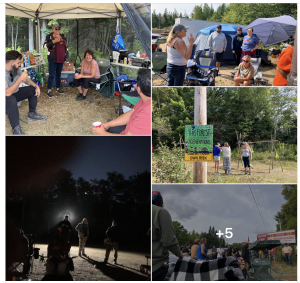 SOOF takes donations and supplies to the Hunters Mountain Mi’kmaw protest
SOOF takes donations and supplies to the Hunters Mountain Mi’kmaw protest
Nina Newington on Friends of Goldsmith Lake FB page, cc’d on NSFM
“Today the Assembly of Mi’kmaw Chiefs announced that Port Hawksbury Paper ‘has suspended all current forest management activities on the Cape Breton Highlands.’ The Hunters Mountain Mi’kmaw action has been remarkably effective so far. Logging equipment has left the mountain, without the piles of logs the transporters were carrying. These were offloaded at the head of the logging road where the camp was established less than a week ago. A couple of us went up on Tuesday with supplies and donations from SOOF. It was a powerful experience to be there…Read more.
Aug 15, 2025
 We aren’t helpless. It just feels that way.
We aren’t helpless. It just feels that way.
NN on FB, Aug 15, 2025
Sorry but we need to face this. It is not just Annapolis County that is in a state of emergency. We are getting a taste of what is to come. The rate of change to global temperatures should be front and centre. In the two years since this post was written, the acceleration has become obvious.
There is no normal to get back to, only concerted, collective action to stop digging a deeper hole. Slash emissions, reduce consumption, take care of nature and each other as best we can. We can do this. Look at how people step up in a crisis in our small corner of the world.
We aren’t helpless. It just feels that way.
Aug 15, 2025:
Protect Ingram River Wilderness Area on FB
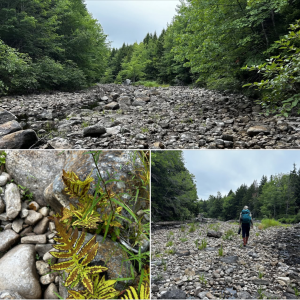 Our Summer Aquatic Habitat Restoration Technicians have obtained a permit by the Department of Natural Resources to continue work to restore the Ingram River during the travel restrictions in Nova Scotia, following restrictions. Being on the Ingram River during this dry season has shown us the impact the drought conditions have on our local rivers and wildlife. Areas within the Ingram River area have completely dried up, leaving no room for fish passage. What water is present is shallow, narrow, and super-heated to a point of potentially being lethal for many of our native aquatic species.
Our Summer Aquatic Habitat Restoration Technicians have obtained a permit by the Department of Natural Resources to continue work to restore the Ingram River during the travel restrictions in Nova Scotia, following restrictions. Being on the Ingram River during this dry season has shown us the impact the drought conditions have on our local rivers and wildlife. Areas within the Ingram River area have completely dried up, leaving no room for fish passage. What water is present is shallow, narrow, and super-heated to a point of potentially being lethal for many of our native aquatic species.
The surrounding forest is showing signs of stress too, with dried ferns and vegetation, and yellowing leaves on trees. These signs show the extreme risk present in the woods and the reasoning for the provincial restrictions against travel and activities, to prevent wildfires. Help protect your forests, yourself, local firefighters, and the community, by staying out of the woods.
For questions and concerns regarding the provincial restrictions call your local Department of Natural Resources.
Aug 11, 2025:
Linda Pannozzo on FB
 Forests don’t all burn the same way — industrial forestry in this province has created the tinderbox… and the forest industry actually bears a lot of this burden. But the burden is being applied disproportionately on those, who for whatever reason, want to enjoy the forests for recreational purposes. We need to lay blame where blame is due. NS forests have been transformed from Acadian forests (old growth, multi-species/ aged) into a young, single species, single aged tinderbox, with the added violation of glyphosate applications, which only make things drier. Acadian forests did not experience large-scale disturbance like fires — the disturbance regime was mostly small scale — resulting in small gaps in the forest canopy. Clearcutting and industrial forestry is to blame for a lot of this. If policy / laws are going to be made, they need to be made based on facts and reason, and the root cause of the problem has to be addressed. It should not basically ignore the root causes — even allowing those egregious practices to continue — while demonizing individuals, and treating everyone as if they were an arsonist, by creating snitch lines, and exorbitant fines. If the government is really authentic in its desire to make NS forests safer from wildfire then they need to transform forest policy to reflect the damage it’s already done.
Forests don’t all burn the same way — industrial forestry in this province has created the tinderbox… and the forest industry actually bears a lot of this burden. But the burden is being applied disproportionately on those, who for whatever reason, want to enjoy the forests for recreational purposes. We need to lay blame where blame is due. NS forests have been transformed from Acadian forests (old growth, multi-species/ aged) into a young, single species, single aged tinderbox, with the added violation of glyphosate applications, which only make things drier. Acadian forests did not experience large-scale disturbance like fires — the disturbance regime was mostly small scale — resulting in small gaps in the forest canopy. Clearcutting and industrial forestry is to blame for a lot of this. If policy / laws are going to be made, they need to be made based on facts and reason, and the root cause of the problem has to be addressed. It should not basically ignore the root causes — even allowing those egregious practices to continue — while demonizing individuals, and treating everyone as if they were an arsonist, by creating snitch lines, and exorbitant fines. If the government is really authentic in its desire to make NS forests safer from wildfire then they need to transform forest policy to reflect the damage it’s already done.
Jun 30, 2025:
 Nova Scotia Forests Forever
Nova Scotia Forests Forever
Announcenent in the Blomdon Naturalists July 2025 Newsletter:
“Nova Scotia Forests Forever (NSFF) is a new social media campaign led by Hutchinson’s Maple Syrup with the support of the Blomidon Naturalists that aims to educate and advocate for rapid implementation of the NS governments commitment to protect 20% of the province by 2030, including the Chain Lakes. In the meantime, there needs to be pause on all resource development in proposed protected areas until the target is met.
Second, NSFF stands for a reinstatement on the ban on uranium mining exploration and development. Finally, it supports policies that protect and restore the Wabanaki Forest as conservation priority and a path toward reconciliation, climate resilience, and community renewal with health and economic benefits. Alyssa Gomez and Lynnette Alford are leading the campaign and generating excellent content and expanding the reach on Facebook and Instagram.
Check out the website here, and follow them on Facebook and Instagram. They are generating some great content, videos, and stories. Please share it with your 500 “best” friends.”
May 16, 2025:
 – April Showers bring May Warblers
– April Showers bring May Warblers
Nature NS ” We’re getting into warbler season now! Did you know there are over 20 warbler species that breed in Nova Scotia? That’s a lot of birds, and all from one family! Nova Scotia supports breeding and stopover habitat for hundreds of bird species. It’s vital that we protect it. Visit us at www.naturens.ca for ways to take action for birds – from coastal protections to ecological forestry to urban planning and more.
Apr 22, 2025:
– Tick season is here. What to know about Lyme disease, anaplasmosis and more tick-borne illnesses
Chris Stooley on yahoo news. Useful info about diseases carried by ticks, symptoms, occurrence in different regions of Canada.
Apr 19, 2025
Grandmother Birch on Fireweed
by Ruth Lapp in Grandmother Birch Newsletter, reproduced on NSFM with permission.
“Lately, I have been contemplating the notion of ‘healing’– not only from the aches and pains that beset us all in our physical bodies, but more so, the hurts of our hearts and our spirit. I think we might all agree, this is truly a time for fireweed…In the early spring look for the first tender shoots of fireweed. Delicious ”
 Apr 13, 2025:
Apr 13, 2025:
– Lichen Camp 2025 Up and Running
Nina Newington on Friends of Goldsmith lake Wilderness Area, reproduced on NSFM “Happy to say Lichen Camp 2025 is up and running in the same spot as last year’s camp. We — a loose collection of people working to protect the proposed Goldsmith Lake Wilderness Area — are excited to continue with our research and education initiatives. It is our hope that this magnificent area will soon be identified as a candidate for protection to help the province meet its goal of protecting 15% of our lands and waters by the end of 2026.”
 – NS Forest Matters frontispiece
– NS Forest Matters frontispiece
The photo is of mature/old growth hardwood forest by Sandy Lake (Bedford, NS) on March 23 2021. It illustrates Christmas ferns on a mound – the resting place of a very big tree that fell about 150 years earlier. View On bathing in the water and in the forest at Sandy Lake – in March! 26Mar2021 Also view The Evergreen Christmas Fern by Susan Shea in The Outside Story (Northern Woodlands) Dec 16, 2024 “In winter, the fronds of these ferns are often flattened against the ground. Studies have shown that the first hard frosts stimulate development of a hinge zone at the base of the stem, which causes the fronds to fall over. The prostrate fronds benefit from the warmth and protection of leaf litter, which helps to prevent the leaves from freezing. Humidity is trapped beneath the ferns’ leaves, reducing desiccation. The leaves continue to photosynthesize during winter at a reduced rate. When fiddleheads emerge in spring, covered with silvery scales, the old fronds die. Spring Christmas ferns include fertile fronds in the center of the clump…”
Mar 28, 2025:
MacDougall’s maple sugarworks
by Dirck van Loon on Portly Bear Tidings “…Sugar maples do not grow in Riversdale, only Reds. Not to be thwarted, Andrew drilled, tapped, and boiled about 100 litres over an open fire.”
Mar 26, 2025:

Click to enlarge. Learn More link: https://www.forestryforthefuture.ca/faq
Forestry for the Futures’ Misinfo continued…
I received a message: “March Into Canadian Forestry: Resources & Facts” from Forestry For The Future sansreponse@fpac.ca (graphic at right). The line that jumped out at me: “Canadian forestry practices include the strategic harvesting and regeneration of forests, which enhances carbon capture. Younger trees absorb carbon faster than older ones, helping to improve the overall carbon sequestration potential of Canada’s forests. ” Comment: Yes younger trees do “store carbon faster” but FPAC knows full well that whether that “helps to improve the overall sequestration” depends on how much older forest storing a lot more carbon is removed at the same time. The statement is a deliberate simplification. For a more nuanced, evidence based perspective, see recent paper by Betts et al. discussed in this post on NSFM: A second scientific paper by MG Betts & colleagues further documents “Forest Degradation” in Maritime Canada 31Oct2024
Mar 8, 2025:
 Uranium bedrock is located in these areas of NS
Uranium bedrock is located in these areas of NS
TLR on Concerned Citizens of & for Nova Scotia. “Uranium bedrock is located in these areas of NS. “At the levels of uranium detected in some bedrock aquifers in Nova Scotia (>20 μg/L), long-term ingestion of well water from these aquifers can cause kidney disease. About 42% of Nova Scotians are supplied by private wells and these water sources are not monitored or regulated with respect to water quality. Effective communication of the health risks associated with the ingestion of uranium in drinking water from private wells is critical for reducing uranium exposure and protecting human health.” https://novascotia.ca/natr/meb/data/pubs/20ofr01/ofr_me_2020-001.pdf
Mar 5, 2025:
 Save Our Old Forests (SOOF) Presentation to Town of Annapolis Royal
Save Our Old Forests (SOOF) Presentation to Town of Annapolis Royal
“Many thanks to the Council of the Town of Annapolis Royal for giving Save Our Old Forests some time on the Committee of the Whole agenda on Wednesday March 5.
We shared highlights of the work done by the Citizen Scientists of Southwest Nova Scotia in the forests around Goldsmith Lake Wilderness Area. We talked about the Canada – Nova Scotia Nature Agreement and that Nova Scotia must protect 15% by March 2026 as part of the agreement. We talked about how harvest plans are still being approved by the Department of Natural Resources within the proposed Goldsmith Lake Wilderness Area.
Council was very receptive to our request and also expressed thanks and admiration for all the volunteer work SOOF and the Citizen Scientists put in. They’ll be voting on the request and then, assuming the motion passes, will write a letter to the Premier in support of making the Goldsmith Lake Wilderness Area a candidate area for protection in time for it to be included in the interim target of protecting 15% of Nova Scotia.
It’s always great to have SOOF Friends and Volunteers come out to show their support…. thank you to everyone that came out on Wednesday night!
Feb 25, 2025:
– LETTER by Michelle Schofield Bull“
Posted on the “Protect Nova Scotia Democracy Facebook Group – February 25, 2025.

Majestic yellow birch are the main long-lived species in most of the old-growth stands in the proposed Goldsmith Lake Wilderness Area. Many are over 200 years old, with quite a few over 300.
– Nina Newington: Good news about Goldsmith.
On Friends of Goldsmith Lake Wilderness Area (Public FB group Feb 25, 2025)
Not THE good news we all hope for, that the Goldsmith Lake Wilderness Area will be identified as a candidate area for permanent protection, but another step in the right direction.
On February 21st, 12 more stands of officially recognized old-growth forest were added to the 3 already there.
Now it should be clear for all to see what an extraordinary gem Goldsmith Lake is. A pristine lake surrounded by 15 stands — 250 acres — of old growth forest! That’s rare as hen’s teeth in our heavily logged province. It is exceedingly rare on the South Mountain. Read More
Feb 21, 2025:
– Citizens respond to Bills 1 and 6
Page on this website. Three letters circulating on social media in which citizens respond to the PC Gov’s recently introduced Bill 1 (An Act Respecting Government Organization and Administration) and Bill 6 (An Act Respecting Agriculture, Energy and Natural Resources).
Feb 19, 2025:
 Exploring Nova Scotia…Nova Scotia has 70 wilderness areas
Exploring Nova Scotia…Nova Scotia has 70 wilderness areas
Exploring Nova Scotia FB Page “Nova Scotia has 70 wilderness areas, covering approximately 5% of the province’s landmass. These protected areas preserve natural landscapes, wildlife habitats, and biodiversity while offering opportunities for hiking, paddling, and wildlife viewing. They include diverse ecosystems, from coastal barrens to Acadian forests, helping to conserve rare species and maintain ecological balance. Popular wilderness areas include Tobeatic, Ship Harbour Long Lake, and Cloud Lake, each offering unique outdoor experiences.
Also you can camp in these areas as long as its low impact, Would you camp alone in the wilderness?
Feb 12, 2025:
– Chainsaw Elegy
by Mike Lancaster on Healthy Forest Coalition Blog. It begins with an ode to practicing chainsaw forestry in winter” The frost hangs heavy on the spruce boughs,A cushioning silence stretched between each trunk…” Comments ML:
“Conducting forestry by chainsaw has become a diminishing skillset over the decades as hard-working folks and their saws have largely been replaced by big machines that can do the work of more than 10, requiring just 1 to operate them. There are still holdouts, dedicated to their craft, doing forestry in a way that is increasingly seen as outdated, with a dogged, almost romantic, desire to make a living off the forests they love without overly harming them. These are the folks that we need to support, lifting them up as examples of the value-added, reduced-impact forestry that we wish we could see more of across Nova Scotia. “
Feb 4, 2025:
 – Protect Owls Head Provincial Park. IG: Take action and keep writing letters to the editor. Today’s paper: Have courage to engage special interest groups; Extract details about mining expansion; Preserve core sectors of NS economy.
– Protect Owls Head Provincial Park. IG: Take action and keep writing letters to the editor. Today’s paper: Have courage to engage special interest groups; Extract details about mining expansion; Preserve core sectors of NS economy.
Jan 25, 2025
– Màiri Cairistìona/Protect Guysborough Letter to Premier “…The reason I am writing today is in response to your push to revisit the ban on fracking as well as your support in giving the green light to renewable energy projects such as windmills and hydropower, and mining for lithium… I think we need to be extremely careful in planning these projects to ensure they will not have a devastating impact on the environment in the process…”
Jan 1, 2025
 – This could be one of the most important videos you ever watch
– This could be one of the most important videos you ever watch
Oct 14, 2009 Video by UNILAD, reposted by Bev W. A short video on how to survive a fall through the ice. Said Bev W: “SHARING — I’ve seen this a couple of times before as it’s been up online for a few years. It just came up on my news feed again and it’s really worth re-sharing. Such a good demonstration of self-rescue after breaking through ice. As a few people mentioned in the comments, after falling through ice, the hardest thing is to not panic. One person mentioned that, when growing up in Sweden, this was taught to kids in school. Important knowledge if you spend any time out walking on frozen ponds or creeks.”
- An update on the Corbett and Dalhousie Lakes Peninsula
by Nina Newington on Annapolis Environment & Ecology (Public FB Group)
On Boxing Day six years ago, local resident Bev Wigney organized a gathering on the peninsula between Corbett and Dalhousie lakes. She shone a light on the value of the old, beautiful forest there to wildlife and to people. Read more on this website.
Dec 6, 2024:
 – North Nova Forest Owners Co-op Ltd.
– North Nova Forest Owners Co-op Ltd.
We’ve had a few posts that show or talk about the importance of trees blowing down from an ecological perspective. He is a better view of the structures that creates.
It creates what is called pit and mound topography in forestry terms. The mound is the structure created by the soil settling over time and and the woody material decaying. The pit is the hollow created where the water is in the picture.
These both are important for many reasons including site productivity, creating a microsite and soil mixing and aeration to name a few.
Dec 2, 2024:
– On Annapolis Environment & Ecology (Public FB Group), Post by B.W. related to “Restoring Wabanaki forest in Cumberland County”
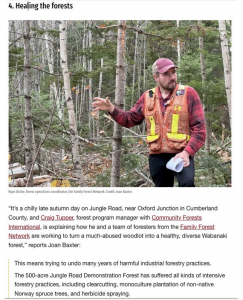 GOOD READ:: Excellent article about the forest industry by Joan Baxter at Halifax Examiner. You can go to my post on BlueSky and click on the link to take you directly to a précis of the article. If you want the read the whole thing (well worth your time to read), you do need to be a subscriber to the Halifax Examiner — which is a good thing to do as it is now one of the only news sources featuring investigative reporting remaining in our province.
GOOD READ:: Excellent article about the forest industry by Joan Baxter at Halifax Examiner. You can go to my post on BlueSky and click on the link to take you directly to a précis of the article. If you want the read the whole thing (well worth your time to read), you do need to be a subscriber to the Halifax Examiner — which is a good thing to do as it is now one of the only news sources featuring investigative reporting remaining in our province.
LINK to précis of the article. This goes to my BlueSky post about it and you can click on the link there to get to the Halifax Examiner.
https://bsky.app/…/bwigney.bsky.social/post/3lcdgu3bzw22o
– Morning File Link
– ‘We want it messy’: Forest experts work to undo decades of bad forestry practices in Nova Scotia
Article by Joan Baxter in the Halifax Examiner Dec 2, 2024 “Restoring Wabanaki forest in Cumberland County to increase climate resilience and biodiversity, reduce fire and flood risk. ”
Some Comments on the FB Post:
RP: I wish there was more help for landowners to do this kind of regenerative work, joining a trust or community group isn’t feasible everywhere and government really should be stepping up
DGP: Cumberland Co, was really Ground Zero for Industrial Forestry in NS, shows it today.
GF to DGP: Sure was . I was there when the first feller buncher was unloaded on Westchester mtn. 1982 or 83 I believe. They cut 600 acres in 20 days . Since then some of the area was replanted. Most of it came up in natural regeneration being fir. It was spaced then merchantable thinned. However the trees have returned to the original condition they were cut to start with. Rotten cores and dieing . The copiguid pass twined highway went slap through the middle of it . The owner fought the government explropiated. The first week the new highway opened 5 main land moose were killed.
DGP to GF: Wow. Thx for sharing. A Parrsboro-born friend told me this one: “You can’t grow a 150 year-old tree in 50 years.” – Comment by an elder forester when the Stanfield government held hearings in Cumberland Co. in the early 1960s to promote its plans to clearcut in support of a new pulp mill planned for Pictou and told woods people, “Now you will be able harvest every 50 years”. (Source: an elder from Parrsboro area).
GF: It’s easy to get good forestry. Just insure people that own it get fair prices, the owners will do the rest with out government help. A 2×4 selling under $4 each does nothing for good forestry but provides cheap housing to those that can pay $10 for the same piece. Covid proved that.
Nov 26, 2024:
 – Lisa Proulx on Friends of Goldsmith Lake Wilderness Area
– Lisa Proulx on Friends of Goldsmith Lake Wilderness Area
“As soon as we heard about the new cut block that was posted for comment in the Harvest Plan Map Viewer (HPMV) within the boundaries of the proposed Goldsmith Lake Wilderness Area, we had a crew at the ready. 8 Citizen Scientists showed up and spent the day, bushwhacking, lichen hunting, measuring trees, tripping, sinking in muckholes, laughing and generally having a good time. Plus we found protected Species at Risk! Take a look at the map.
So, even though we have shown Natural Resources and Renewables (NRR) that we are capable and interested in working with them within their own Collaborative Protection Strategy, they still want to allow logging in these sensitive, ecologically diverse areas. There are lots of other areas to do their logging in that are NOT proposed for protection. We just want this area to have a chance to be included in the 20% protected by 2030, before it gets riddled with even more roads and logging. Time will tell if our comments on the HPMV will make a difference!”

Nov 22, 2024 North Nova Forest Owners Co-op Ltd.
– “We’ve heard, seen and talked about hurricane Fiona alot the last couple of years.
 Ever wonder what the forest looks like after a hurricane over time. Here are shots of hurricane Juan which hit in September 2003. That’s 21 years ago and this site was never cleaned up.
Ever wonder what the forest looks like after a hurricane over time. Here are shots of hurricane Juan which hit in September 2003. That’s 21 years ago and this site was never cleaned up.
Take away notes, it didn’t burn and guess what we can work in there now. The site is doing quite well.”
Nov 15, 2024:
 Post by Lisa Proulx on Friends of Goldsmith Lake Wilderness Area
Post by Lisa Proulx on Friends of Goldsmith Lake Wilderness Area
“A hike in the woods in the proposed Goldsmith Lake Wilderness Area today with some eager students from NSCC’s Centre of Geographic Sciences (COGS) forestry class yielded a new occurrence of possible Frosted Glass Whiskers! (Aka Sclerophora peronella, a protected species at risk, pending confirmation) We love to see young people getting involved in learning about old forests and Species at Risk. It was a cold, wet and yes snowy day! But well worth the effort!”
Sep 27, 2024:
– Sugar Maple Stands & Ecological Forestry (Audio)
Blomidon Naturalists In Conversation series. “In this episode, we chat with local sugarbush farmer Chris Hutchinson, whose ecological forestry practices help keep over 700 acres of forest healthy. Then we chat with Alan Warner about the proposed Chain Lakes Wilderness area and how those same ecological forestry practices can help safe guard our forest for the future.”
Sep 16, 2024:
No Spray Bear River 2024: Glyphosate spraying is happening again in the 2024 season
Re-Post of the initial post by No Spray Bear River 2024, Public Facebook group formed on Sep 8, 2024. “This year there are two sites in L’Sitkuk/Bear River that we are working hard to protect in Victory area. This is our backyard, where we hike, swim, camp, fish, and explore the nature at the edge of the Tobeatic wilderness. We can’t let the biodiversity of these areas be put at risk by glyphosate spraying. Victory is OURS!..”
Sep 15, 2024:
 Did You Know
Did You Know
TLE on Protect Guysboro, public Facebook Group created on created on August 6, 2024. “We are a group of citizens concerned about lack of public consultation and transparency regarding 500+ industrial wind turbines proposed for Guysborough County. Not one of these wind turbines will be built to power our grid—instead proponents will use wind energy to export ammonia overseas.” In the post, TLE expresses Thanks to those who joined us at the Community Information Session today to learn about what is happening throughout Guysborough County.”

